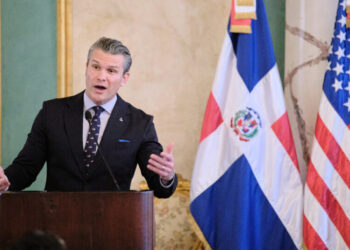U.S. Army secretaries are not usually involved in negotiating peace deals. But last week, the Army secretary, Daniel Driscoll, was in Ukraine doing just that.
Mr. Driscoll, nicknamed the “drone guy” for his interest in the battlefield technology, visited Kyiv to present the latest iteration of President Trump’s peace proposal to the Ukrainians. He became the highest-ranking Trump administration official to make the trip.
The proposal, aimed at pressuring Ukraine to make concessions that the country’s president and allies had already rejected, leaked to the public before Mr. Driscoll arrived. European leaders widely criticized it as a series of concessions to President Vladimir V. Putin of Russia, such as ceding more territory to Russia, limiting the size of Ukraine’s army and ruling out its membership in NATO.
But Mr. Driscoll pushed on, orchestrating a phone call last Friday between Vice President JD Vance, a friend from Yale Law School, and President Volodymyr Zelensky of Ukraine. The skeptical Ukrainian officials continued talking, while defenders of the administration’s approach argued that the war could end only if Ukraine agreed to make painful compromises.
By Saturday, Mr. Driscoll was flying to Geneva for weekend negotiations involving more senior officials — Secretary of State Marco Rubio and a Trump envoy, Steve Witkoff — and a Ukrainian delegation.
And two days after that, Mr. Driscoll was meeting with a Russian delegation in the United Arab Emirates. “We remain optimistic,” said Lt. Col. Jeff Tolbert, an Army spokesman.
Many analysts doubt that this latest round of talks will bring peace to Ukraine after nearly four years of Russia’s war. But one thing appears clear: Mr. Driscoll, a 39-year-old former Army lieutenant colonel, is on the rise in the Trump administration.
Mr. Driscoll has also garnered support on Capitol Hill.
He is viewed by many in Congress as one of the few Trump administration Pentagon officials who can work with lawmakers in both parties, two congressional aides said. While Defense Secretary Pete Hegseth has tried to limit direct communications between military officials and lawmakers, Mr. Driscoll has responded to requests from Republicans and Democrats alike in the Armed Services Committees, the aides said.
During his nomination hearings, Senator Elizabeth Warren, Democrat of Massachusetts, pressed him to commit to allowing the Army to repair its own equipment, instead of sending it back to defense contractors. Months later, Mr. Driscoll did so, putting the policy, known as “right to repair,” in place and earning a rare plaudit for a Trump administration official from a Democratic lawmaker (and one who had voted against his nomination).
“I pushed the Army secretary to get right to repair in the Army done, and I’m glad he kept his word,” Ms. Warren said in a statement in May. She said it would be “a big win for our country if all of the services followed Secretary Driscoll’s lead to stand up to military contractors, side with war fighters, and commit to right to repair in every single contract.”
While in the Army, Mr. Driscoll deployed to Iraq for nine months. He left active duty after three and a half years and later worked as an investment banker in North Carolina, where he is from.
The Army is the country’s biggest military service, with 453,000 active-duty and 499,000 National Guard and Reserve troops. The Army secretary’s job usually consists of tending to the Army’s budget, meeting with defense contractors and finding ways to modernize. He or she also advises the defense secretary on the Army’s needs.
The decision to send Mr. Driscoll, instead of Mr. Hegseth or Gen. Dan Caine, the chairman of the Joint Chiefs of Staff, to the meetings in Ukraine might have been partly based on convenience. Senior Army officials were already planning a trip to the country.
The Trump administration may have also been making a calculation. Ukrainian military officials have a long history with the U.S. Army, which trained Ukrainian troops even before the war.
Asked why Mr. Driscoll, and not Mr. Hegseth or General Caine, was handling the negotiations, a Pentagon spokesman, Sean Parnell, said in an email that “the secretary has built an all-star team at the Department of War, and we are proud of our many accomplishments.”
Mr. Driscoll and General Caine have different views of the Ukrainian military’s prospects, one current and two former officials said. While General Caine agrees with Mr. Trump’s Ukraine envoy, Keith Kellogg, who believes that the Ukrainians still have the wherewithal to turn things around, Mr. Driscoll is much less optimistic. The officials said that Mr. Driscoll believes that the war must be settled soon, including on terms more favorable to Russia, because Ukraine’s military is near a breaking point.
In Russia, some have welcomed Mr. Driscoll as an apparent replacement for Mr. Kellogg, who is leaving his post in January, according to a White House official.
Mr. Driscoll is “reasonable,” a former senior Russian official said, unlike Mr. Kellogg, whom the Kremlin saw as representing Ukraine’s position.
After the meetings in Abu Dhabi, Mr. Trump said on Tuesday that Mr. Driscoll would continue to be involved in the peace talks.
“In the hopes of finalizing this Peace Plan, I have directed my Special Envoy Steve Witkoff to meet with President Putin in Moscow and, at the same time, Secretary of the Army Dan Driscoll will be meeting with the Ukrainians,” the president said on social media.
Helene Cooper is a Pentagon correspondent for The Times. She was previously an editor, diplomatic correspondent and White House correspondent.
The post U.S. Army Secretary’s Unusual Role in Ukraine Peace Negotiations appeared first on New York Times.




